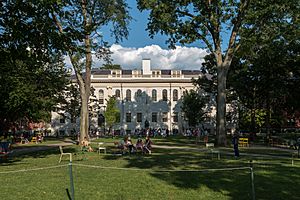Legacy preferences facts for kids

Legacy preference (also called legacy admission) is when a college or university gives special treatment to students whose parents or other family members went to that same school. These students are often called legacies or legacy students. This practice is very common in college admissions in the United States. Many top universities and colleges use legacy preference.
This special treatment can mean it's easier for a legacy student to get into a school. Some schools only give this benefit to children of former students. Others extend it to grandchildren, siblings, nieces, or nephews. A study in 2005 looked at many student records. It found that being a legacy could increase a student's chance of getting in by almost 20%. This was true even for students with similar test scores.
Legacy preference is a debated topic. Some people argue it's not fair because legacy students might not be as qualified as other applicants. Also, fewer legacy students come from diverse backgrounds. However, universities often benefit financially from legacy students. They believe these students and their families are more likely to donate money to the school later on. This practice is especially common at famous schools like those in the Ivy League.
How Legacy Preference Started
In the United States, colleges began using legacy admissions in the 1920s. At that time, some elite schools wanted to keep spots for certain groups of students. They were worried that more Jews, Catholics, and Asians were getting into these schools. So, legacy admissions helped them maintain a certain student body makeup.
A survey in 1992 looked at the top universities. It found that almost all of them used legacy preference. Only a few, like the California Institute of Technology and the Massachusetts Institute of Technology, said they did not. Most liberal arts colleges also used this system. Only Berea College stated it did not.
However, some top schools have stopped using legacy preference in recent years. For example, Johns Hopkins University ended it in 2014. Pomona College stopped in 2017, Amherst College in 2021, and Wesleyan University in 2023.
Comparing Legacy Preference to Other Programs
Legacy preference can have a big impact on college admissions. Its effect can be similar to other programs. These include recruiting athletes or policies like affirmative action. Affirmative action aims to help groups that have faced discrimination.
One study looked at three private universities. It showed how much different factors could help or hurt an applicant's chances. This was measured in SAT points (out of 1600):
- African Americans: +230 points (an advantage)
- Hispanics: +185 points (an advantage)
- Asians: -50 points (a disadvantage)
- Recruited athletes: +200 points (an advantage)
- Legacies (children of former students): +160 points (an advantage)
Even though some groups of students of color might seem to have an advantage, legacy preference often makes it harder for them to get in. This is because most legacy students are white. A 2008 study at Duke University showed that legacy students were more often white, Protestant, and from private high schools. In 2000-2001, out of 567 legacy students at Princeton, only a small number were Latino or Black.
A 2005 study found that half of legacy applicants came from families with very high incomes. This was much higher than for non-legacy students. In 2003, Texas A&M University (which no longer uses legacy admissions) admitted many more white legacy students than Latino or Black legacy students.
In the 1990s, the University of California system stopped using affirmative action. Soon after, they also stopped giving legacy preference.
The Supreme Court, the highest court in the U.S., has discussed college admissions. In 2003, the Court said that colleges could consider race in admissions in some cases. However, Clarence Thomas, a Supreme Court Justice, was critical of legacy preferences. He was the only Justice who grew up in poverty.
Most Americans do not support legacy admissions. However, many people in important positions in government and law have benefited from it. This makes it harder to change the practice.
See also
- Affirmative action
- Class discrimination
- Nepotism

